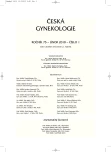Primary sebaceous carcinoma of the breast; three casuistic reports
Authors:
Z. Kinkor 1; I. Mečiarová 2; F. Havlíček 3
Authors‘ workplace:
Bioptická laboratoř s. r. o. a Šiklův ústav patologie, LF UK, Plzeň, vedoucí prof. MUDr. A. Skálová, CSc.
1; Ústav patologie, Alfa Medical, FN Ružinov, Bratislava, vedoucí doc. MUDr. F. Ondriaš, CSc.
2; Oddělení patologie, Nemocnice Benešov, s. r. o., vedoucí prim. MUDr. F. Havlíček
3
Published in:
Ceska Gynekol 2010; 75(1): 50-53
Overview
Objective:
Presentation of three cases of primary sebaceous carcinoma of the breast particularly focusing on the clinical, biological and molecular genetic aspects regarding their possible pathogenetic relationship to the Muir-Torre and Lynch syndrome. Reviewed are basic principles of miscosatellite instability and dysregulations of mismatch repair genes by these inherited tumorous syndromes especially looking for morphologic and fenotypic parallels between sebaceous carcinomas of the breast and their cutaneous counterparts.
Design:
Three casuistic reports.
Setting:
Biopsy Lab s.r.o. and Šikl’s Department of Pathology, Charles University and Faculty Hospital, Pilsen.
Methods:
Three casuistic reports are covered in detail including broad immunohistochemistry (LSAB+, Dako).
Results:
In three women aged 51 to 69 was diagnosed primary sebaceous carcinoma of the breast with maximum dimension ranged from 13 to 41 mm. Lumpectomy was performed at the smallest one and included sentinel lymph node examination turned out to be negative. The other two patients underwent modified mastectomy with axillary lymph node dissection. In tumor sized 25mm, macrometastasis 4mm in maximum dimension was identified in one axillary lymph node. Follow-up available in two women, both without regional metastasis, revealed no local or distant progression of the disease. The histology consisted of conventional G1-2 invasive duct carcinoma in all cases and sebaceous differentiation represented 10-40% of all neoplastic population. The patognomic features included cells with ample eosinophilic/clear foamy cytoplasm, partly with multiple crowded small vacuoles characteristically impressing the nuclei. All tumors were ER positive and Her2/neu 2+ lesion was not amplified. Strong diffuse nuclear expression of MLH1, PMS2, MSH2, MSH6 proteins in all cases confirmed unaltered mismatch repair genes pathway. Familial tumorous stigmas were not evident and subsequent close clinical monitoring in two of the patients tracked down no intern malignancy, including cutaneous sebaceous lesion.
Key words:
breast, sebaceous carcinoma, microsatellite instability, mismatch repair genes, Muir-Torre syndrome, Lynch syndrome, familial nonpolypous colorectal carcinoma.
Sources
1. Garg, K., Soslow, RA. Lynch syndrome (hereditary non-polyposis colorectal cancer) and endometrial carcinoma. J Clin Pathol, 2009, 62, p. 679-684.
2. Hisaoka, M., Takamatsu, Y., Hirano, Y., et al. Sebaceous carcinoma of the breast: case report and review of the literature. Virchows Arch. 2006, 449, p. 484-488.
3. Ingram, JR., Griffiths, AP., Roberts, DL. All patients with sebaceous gland neoplasms should be screened for Muir-Torre syndrome. Clin Exp Dermatol, 2008, 34, p. 240-266.
4. Jiao, YF., Nakamura, S., Oikawa, T., et al. Sebaceous gland metaplasia in intaductal papilloma of the breast. Virchows Arch, 2001, 438, p. 505-508.
5. Karamurzin, Y., Rutgers, KL. DNA mismatch repair deficiency in endometrial carcinoma. Int J Gynecol Pathol, 2009, 28, p. 239-255.
6. Li, ZB., Zhi, XZ. Intraductal papilloma of the breast with sebaceous metaplasia: report of a case. Histopathology, 2007, 36, p. 349-350.
7. Mazzella, FM., Sieber, SC., Braza, F. Ductal carcinoma of male with prominent lipid-rich component. Pathology, 1995, 27, p. 280-283.
8. Murakami, A., Kawachi, K., Sasaki, T. Sebaceous carcinoma of the breast. Pathol Int, 2009, 59, p. 188-192.
9. Orta, L., Klimstra, DS., Qin, J., et al. Towards identification of hereditary DNA mismatch repair deficiency: sebaceous neoplasm warrants routine immunohistochemical screening regardless of patient’s age or another clinical characteristics. Am J Surg Pathol, 2009, 33, p. 934-944.
10. Ponti, G., Losi, L., Di Gregorio, C., et al. Identification of Muir-Torre syndrome among patients with sebaceous tumors and keratoacanthomas: role of clinical features, microsatellite instability and immunohistochemistry. Cancer, 2005, 103, p. 1018-1025.
11. Prescott, RJ., Eyden, BP., Reeve, NL. Sebaceous differentiation in breast carcinoma with ductal, myoepithelial and squamous elements. Histopathology, 1992, 21, p. 181-184.
12. Tavassoli, FA., Norris, HJ. Mammary adenoid cystic carcinoma with sebaceous differentiation. A morphologic study of the cell types. Arch Pathol Lab Med, 1986, 110, p. 1045-1053.
13. Varga, Z., Kolb, SA., Flury, R., et al. Sebaceous carcinoma of the breast. Pathol Int, 2000, 50, p. 63-66.
Labels
Paediatric gynaecology Gynaecology and obstetrics Reproduction medicineArticle was published in
Czech Gynaecology

2010 Issue 1
Most read in this issue
- Non-steroidal anti-inflammatory drugs in pregnancy
- Progesterone neuroactive metabolites in human pregnancy
- Delivery, and anal incontinence later in life
- Abdominal obesity
